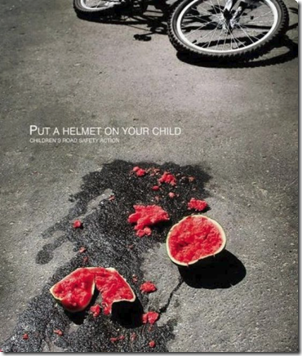Originally posted on April 28, 2019 @ 1:37 AM
Shock and Fear in Safety
 There is a naïve belief in the safety industry that shocking people and the dynamics of fear are effective. We see this in the many ‘horror’ photos and clips in the sector as well as the countless injured people who are trotted out with the message ‘don’t be like me’. Even the regulator runs out such rubbish (Worksafe VIC ). These methods are commonly known as ‘scare tactics’ and are highly ineffective. (The Facts About Scare Tactics )
There is a naïve belief in the safety industry that shocking people and the dynamics of fear are effective. We see this in the many ‘horror’ photos and clips in the sector as well as the countless injured people who are trotted out with the message ‘don’t be like me’. Even the regulator runs out such rubbish (Worksafe VIC ). These methods are commonly known as ‘scare tactics’ and are highly ineffective. (The Facts About Scare Tactics )
One thing I have never done nor will do in my presentations is tell ‘war stories’, ‘horror stories’ or recount in detail the nature of a disaster. Whilst I understand the rationalist logic of trawling through incident investigations and recounting causation in disasters, its not something I do. The same applies to the theory of ‘bootcamps’. There are plenty of reasons not to adopt these methods. Firstly, such stories and methods assume a root cause, which of course there isn’t. and by seeking such a cause naively endorse its mythology. Second, such strategies ignore the many contextual and social-psychological factors that are at play unconsciously in the process of any event. Third, humans are significantly desensitized to shock and fear by such methods and so they have no choice but to escalate more on the belief that the last shock didn’t work because it wasn’t graphic enough.
What is sad about the shock and fear method is they are not only ineffective but actually backfire. Often the outcome of such a method is an inoculation against sensitization to the very factors you want people to be paying attention to. A reverse psychology of sorts.
There is plenty of research to demonstrate that shock and fear are ineffective (https://www.nytimes.com/2008/12/12/opinion/12iht-edlinstrom.1.18632161.html; https://www.timescolonist.com/opinion/editorials/editorial-scare-tactics-don-t-work-1.23117781 ). Another reasons shock and fear is ineffective is because the theory is based on a cognitvist, behaviourist and rationalist construct as if people are ‘converted’ by rational/logical argument. Ah, back to the old anthropology of the human as a computer on a body.
Just present the facts and scare the living hell out of the person and conversion follows, this is the method. None of these methodologies (cognitvist, behaviourist and rationalist) understand humans as whole persons. This is one reason why fear and shock strategies are ineffective.
The assumptions behind the shock and fear method in the safety industry are that humans commit error through wrong belief/habit and that once ‘converted’ out of false habit and belief, one will become compliant/obedient. And therefore ‘sin no more’, hmmm we need more ‘Cardinal rules obviously. This is why so much of safety training is about projecting data onto people and about ‘telling’, as if there is not enough information available to enact a ‘right’ choice. The assumption is that non-compliance is based on either false belief or ignorance.
Underneath this common method is also a theory of conversion. Safety wants people to stop hurting and killing themselves, an admirable wish. Unfortunately, the simplistic methodologies (cognitvist, behaviourist and rationalist) desire to get to such a positive outcome through negative methods. Similarly there are current publications on the safety market that are based on constructivism and structuralism that also assume that culture can be changed by changing structures/organizing (https://safetyrisk.net/culture-about-much-more-than-structure/).
Change can never be achieved without an understanding of both fallibility (https://www.humandymensions.com/product/fallibility-risk-living-uncertainty/), habituation and the psychology of conversion. Three factors that Safety knows so little about.
There is not much research on the psychology of conversion but a few sources may help:
The Oxford Handbook on Religious Conversion
http://www.oxfordhandbooks.com/view/10.1093/oxfordhb/9780195338522.001.0001/oxfordhb-9780195338522
Wiki
https://en.wikipedia.org/wiki/Psychology_of_religious_conversion
A Study on the Psychology of Conversion
It is interesting that Safety has such an interest in belief, faith, habituation, conversion and the emotions (affectivity) but no interest in understanding them. If belief, habit and values are the bedrock of culture, why does Safety know so little about conversion and then expect cultural change???
And so, Safety will continue in ineffective methods believing religiously that they are effective and then wonder why they don’t work. The definition of intelligence comes to mind.



Rob Long says
Thanks John. Not sure the industry wants to listen. Zero is the problem.
John Culvenor says
More good food for thought there Rob.